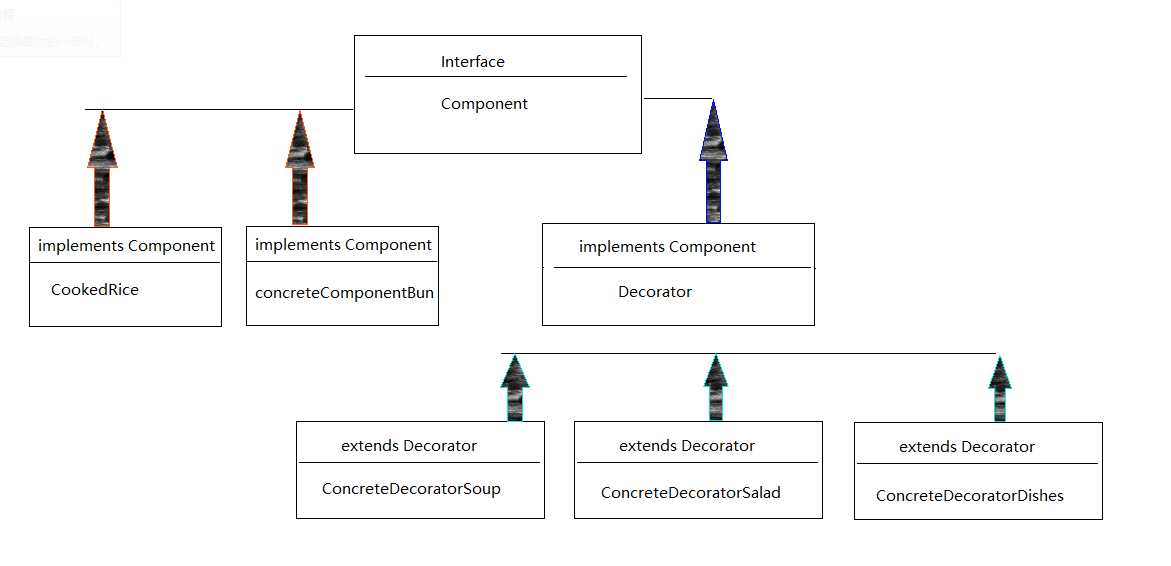标签:
装饰器模式又叫做装饰者模式,是在不必改变原类文件和使用继承的情况下,动态地扩展一个对象的功能。传统的编程模式都是子类继承父类实现方法的重载,使用装饰器模式,只需添加一个新的装饰器对象,更加灵活,避免类数目和层次过多。
Component(被装饰对象基类):定义一个对象接口,以规范准备接受附加责任的对象。
ConcreteComponent(具体被装饰对象):具体组件角色,即将要被装饰增加功能的类。
Decorator(装饰者基类):装饰器接口。
ConcreteDecorator(具体的装饰者类):具体装饰器,向组件添加职责。
需求描述
一个餐饮系统,包含主食和配菜,主食和配菜分别包含不同类别和不同价位。为了保证系统的可扩展性(修改价格,增加或减少主食/配菜种类等需求),使用装饰器模式。
组织架构:

代码展示:
\Libs\Component.php
<?php namespace Libs; /** * 被装饰对象基类 * */ interface Component { /** * 计算所需费用 * */ public function cost(); }
\Libs\ConcreteComponentBun.php
<?php namespace Libs; /** * 定义具体被装饰对象,这里是主食之包子 * */ class ConcreteComponentBun implements Component { public function __construct() { echo "Oh,There is the construct of ConcreteComponentBun.</br>"; } public function cost() { echo "There is the function of ConcreteComponentBun named cost. <br/>"; return 15.00; } }
\Libs\Decorator.php
<?php namespace Libs; /** * 装饰器接口 * */ class Decorator implements Component { public function __construct() { $this->_name = ‘Decorator‘; } public function cost() { return 1.00; } }
\Libs\ConcreteDecoratorSalad.php
<?php namespace Libs; class ConcreteDecoratorSalad extends Decorator { public $_component; public function __construct($component) { echo "Oh,There is the construct of ConcreteDecoratorSalad.</br>"; if($component instanceof Component){ $this->_component = $component; } else { exit(‘Failure‘); } } public function cost() { echo "There is the function of ConcreteDecoratorSalad named cost. <br/>"; return $this->_component->cost()+10.00; } }
\Libs\ConcreteDecoratorSoup.php
<?php namespace Libs; class ConcreteDecoratorSoup extends Decorator { public $_component; public function __construct($component) { echo "Oh,There is the construct of ConcreteDecoratorSoup.</br>"; if($component instanceof Component){ $this->_component = $component; } else { exit(‘Failure‘); } } public function cost() { echo "There is the function of ConcreteDecoratorSoup named cost. <br/>"; return $this->_component->cost()+5.00; } }
\Libs\UseDecorator.php
<?php namespace Libs; class UseDecorator { public static function index() { $bun = new ConcreteComponentBun(); $cost = $bun->cost(); echo "The cost is {$cost} <br>"; echo "_________________________________________________</br>"; $salad_bun = new ConcreteDecoratorSalad($bun); $cost = $salad_bun->cost(); echo "The cost is {$cost} <br>"; echo "_________________________________________________</br>"; $soup_bun = new ConcreteDecoratorSoup($bun); $cost = $soup_bun->cost(); echo "The cost is {$cost} <br>"; echo "_________________________________________________</br>"; } }
调用
Libs\UseDecorator::index();
结果:
Oh,There is the construct of ConcreteComponentBun. There is the function of ConcreteComponentBun named cost. The cost is 15 _________________________________________________ Oh,There is the construct of ConcreteDecoratorSalad. There is the function of ConcreteDecoratorSalad named cost. There is the function of ConcreteComponentBun named cost. The cost is 25 _________________________________________________ Oh,There is the construct of ConcreteDecoratorSoup. There is the function of ConcreteDecoratorSoup named cost. There is the function of ConcreteComponentBun named cost. The cost is 20 _________________________________________________
1). Decorator模式与继承关系的目的都是要扩展对象的功能,但是Decorator可以提供比继承更多的灵活性。
2). 通过使用不同的具体装饰类以及这些装饰类的排列组合,设计师可以创造出很多不同行为的组合。
1). 这种比继承更加灵活机动的特性,也同时意味着更加多的复杂性。
2). 装饰模式会导致设计中出现许多小类,如果过度使用,会使程序变得很复杂。
3). 装饰模式是针对抽象组件(Component)类型编程。但是,如果你要针对具体组件编程时,就应该重新思考你的应用架构,以及装饰者是否合适。当然也可以改变Component接口,增加新的公开的行为,实现“半透明”的装饰者模式。在实际项目中要做出最佳选择。
PHP 设计模式系列 —— 装饰器模式(Decorator)
标签:
原文地址:http://www.cnblogs.com/ddddemo/p/5626731.html